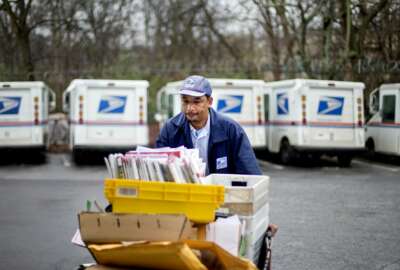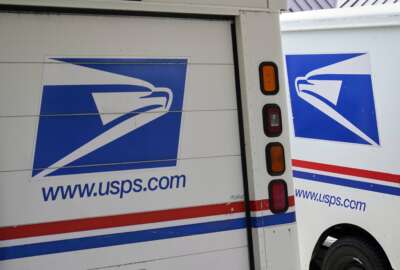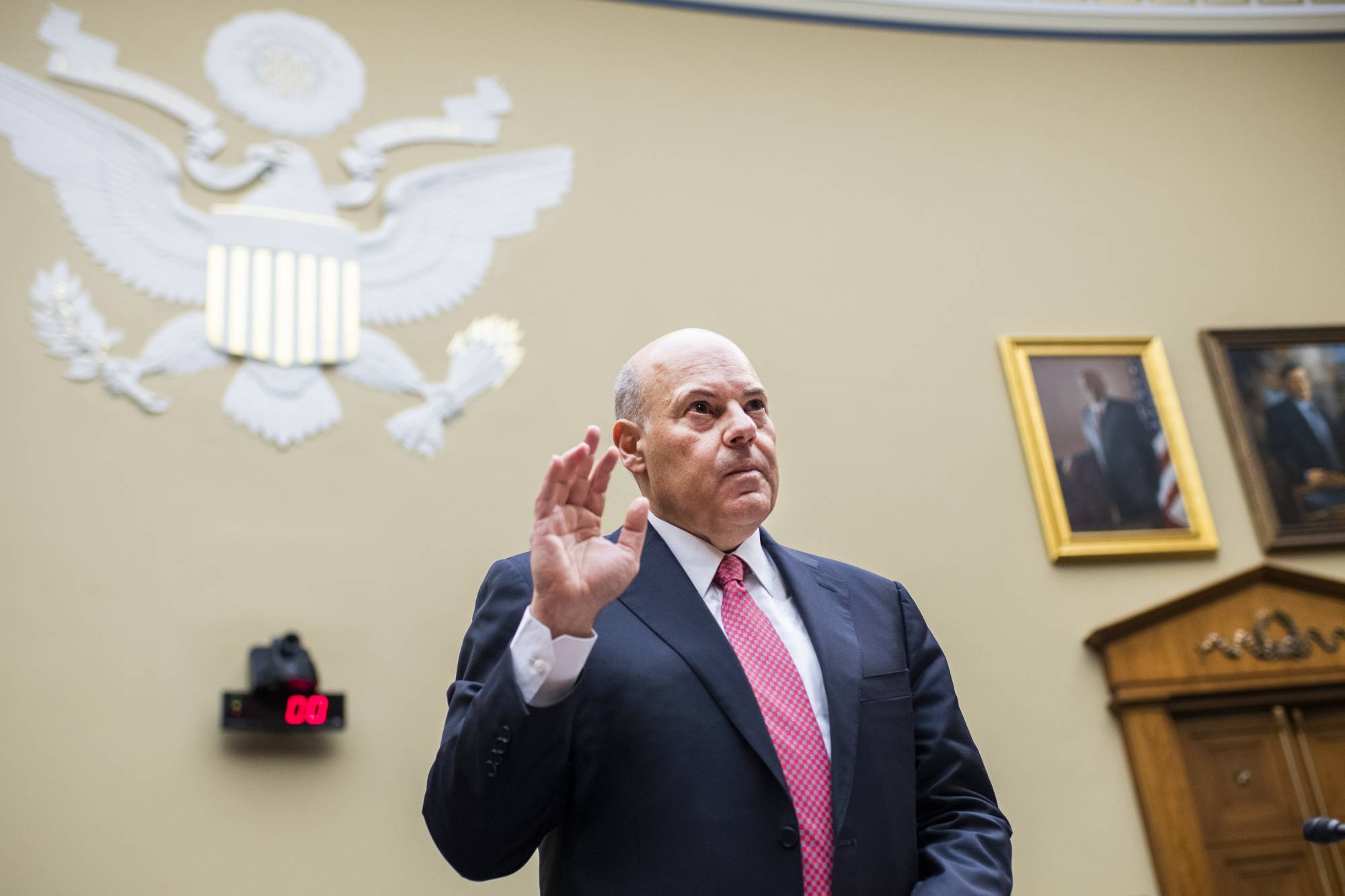The road to electrifying America’s personal vehicles starts with the USPS EV fleet
It's been a major policy initiative of the Biden administration to get more Americans and agencies utilizing electric vehicles.
It’s been a major policy initiative of the Biden administration to get more Americans and agencies utilizing electric vehicles. Well, how about the agency that probably has the largest number of vehicles in its garage? The Postal Service is in the process of electrifying its fleet. To do that though, there needs to be the infrastructure to support them once they do get out there. To get an update on where things currently stand, Federal News Network Executive producer Eric White spoke to Amanda Stafford, Deputy Assistant Inspector General for the USPS’ IG office, on the Federal Drive with Tom Temin.
Interview Transcript:
Eric White Absolutely. So, let’s just start with the goals here that USPS set for itself. What is it exactly trying to do? I imagine electrifying the whole fleet would be ideal, but that’s going to be a huge undertaking. What’s the timeline that they gave you?
Amanda Stafford Well, as part of the delivering for America 10-year plan, the Postal Service plans to transform and modernize their network to improve sustainability, with a goal of not only driving revenue growth, but also reducing its greenhouse gas emissions by 40%. In some key areas by 2030. So, a part of achieving this goal includes replacing a large portion of its delivery fleet of approximately 225,000 vehicles with the purchase and deployment of over 66,000 electric ones. And this Fleet Modernization plan, bases investment is approaching 9.6 billion. So, I think their goal is go through 2030. But they’re trying to move things along quickly.
Eric White All right. And so that’s a pretty massive undertaking, what is required as part of the infrastructure needed to support electric vehicles, you got to have places to charge them and got to make sure that have the proper repair units in place to actually maintain the fleet. What has the Postal Service been able to accomplish so far?
Amanda Stafford Well, in terms of achievement, some of our previous work has noted the successes they’ve had related to the acquisition of charging station infrastructure. We also had a report related to the vehicle maintenance facilities and their preparedness for this effort. Our most recent engagement highlighted that the Postal Service expects to complete the charging station related to construction and deployment at 130 sites by the end of 2024. But as of March 26, the Postal Service confirmed that completed six sites. And by mid-June that just passed, construction was underway at 50 locations, A-2 had also related construction schedule. So, they’re moving things along kind of first, all those planning processes doing the acquisition, and then to your point, kind of making sure they have that charging station infrastructure in place. So that’s all that’s needed prior to rolling out those vehicles.
Eric White As with any major government project, there’s going to be speed bumps along the way pun intended, what sort of delays and challenges has the agency withstood to try and get this thing off the ground?
Amanda Stafford Well, we acknowledge that the Postal Service’s electrification efforts are unprecedented their progress is truly significant. We did find that the first 29 sites that were slated for deployment of the charging station equipment were delayed by an average of 219 days compared to its original schedule. So, it’s a huge undertaking, but they’ve had, as you said, a few bumps in the road to get started.
Eric White And what were the reasons behind those delays? Was it just a personnel issue or were costs problems coming into play because this is probably a lot of moving parts, including a lot of moving dollars.
Amanda Stafford Right. And the charging station construction delays, the Postal Service noted several challenges such as weather site specific conditions like sinkholes, utility specific regulations, and coordination. And while we recognize that a lot of those conditions truly were outside of its control, we found that the Postal Service did not establish realistic completion dates that should have factored in many of these foreseeable issues while planning schedule. So, for example, the construction in the Terre Haute SMDC, which is one of the facilities it’s located in Indiana, was originally supposed to be completed on December 28. Well construction was delayed due to foreseeable weather conditions, that area has predicted temperatures of 28 degrees or lower by the end of October, which makes construction difficult and paving the parking lots where the charging stations are basically impossible. So really in addition, the Postal Service did not really follow schedule management best practices entirely. They really to establish an informed baseline that reflected these conditions and constraints. And really, their schedule was driven by you know, an extremely aggressive business objectives. And then lastly, they didn’t use an overarching project management system that tracked real time updates and the cause of delays. They acknowledged though, that they need to replace that you know, spreadsheet that they were using in the process of not only acquiring but deploying a project management system.
Eric White We’re speaking with Amanda Stafford, she’s Deputy Assistant Inspector General with the US Postal Service IG o Office. And so, what can be done to help them better prepare and execute these vehicle deployment plans, I know you laid out some of the problems that they had as far as planning goes. But you know, when they do incur these delays, what can be done to help speed things up a little bit.
Amanda Stafford To set up the vehicle deployment plans for success, it really is essential to get all that related charging infrastructure in place. So, we had a few recommendations coming out of that specific audit, one to really support the Postal Service preparedness, we recommend that they use best practices to inform a baseline schedule for the future sites. So yes, we’re learning as we go. But as we go forward, can we take those best practices forward. Two, replace their spreadsheet with a project management system, which has dynamic updates and centralizes, all that information and as analytics, and as I mentioned, they’re in the process of addressing that already. And then lastly, to adopt these best practices, we recommended that the Postal Service could explore obtaining outside consultative support, that money could be well spent and fake to help them quickly. Evaluate lessons learned and, and pivot. So as early delays could really jeopardize the ability to use the vehicles which you know, and really achieve these aggressive, aggressive business objectives. So that was our last recommendation in that space.
Eric White Yeah, and I guess the one ray of hope here, I mean, it’s not too dreary. But a hopeful observation would be that these are all very fixable problems. I mean, we’ve interviewed you all before. And there have been, you know, insurmountable issues of, you know, like you said, cost overruns, and things like that. But it seems as if it’s just more organization is needed.
Amanda Stafford Yeah, I don’t think these are insurmountable. Just as you said, the Postal Service is resilient. And I think they can pivot, you know, they were very open and receptive to our recommendations and discussion. And they, you know, during the course of the audit, recognize that they had opportunity. So, I agree with you, I think that this is, it’s a bump in the road, and the deployment is ongoing. And so now they can, they’re in the place to quickly pivot.
Eric White And the Postal Service also has a sort of different approach to this with these incentive programs to actually get this thing moving. How effective has that been? And are people actually utilizing it? Great question. So, for the utility incentive program participation, and in our audit, we identified 13 programs that were currently available, and seven programs that have since expired, and these programs can really allow the Postal Service to save money along the way by partnering with different entities. So, we found that they could potentially have achieved cost savings, around 8 million approximately, for the first 29 sites. Management have previously done some analysis and reviews around the incentive space, but at the time, has decided not to pursue the incentive programs, but rather focus on the implementation of the certain delivery centers. So really, the network modernization to prepare to drive revenue strategies, which is obviously a huge facet of their 10-year plan. You know, we cited some opportunities, I think the Postal Service is going to revisit this space. And I think, you know, we do see that there could be a chance to drive cost savings, which is always an important thing to do. And especially important for the Postal Service itself. Do you foresee that they are happy with this structure that they have set up and are actually seeing positive results from it, they just need a little bit better job executing it would be the way to simple way of simplifying it.
Amanda Stafford I would say that the Postal Service at this juncture and you know, that during the beginning of the audit, and through the course, did not was playing not to pursue this Avenue at that time. There are limitations, which we cited in our report that, you know, there could be required to subcontractors by the program owner, there could be easements and other terms and conditions. But we really asserted that, you know, the continued evaluation could bear fruit, as the postal service may be able to negotiate eligibility terms with program administrators and take advantage of these opportunities. For example, the Postal Service Management say they were not eligible to participate in some of the programs, one that comes to mind, we directly communicated with that representative from the program. And they said, well, actually federal fleet such as the Postal Service, are eligible to register and participate. So, I think it requires a lot of digging additional work. So, we had some recommendations in that space that that they’re pursuing and looking at now based on what we’ve described. So, I think that this could be a facet of their plan, but they’re also balancing that with the need to go very quickly. And there are other priorities related to the 10-year plan. So, we understand kind of the balance that they’re trying to continue to have.
Copyright © 2025 Federal News Network. All rights reserved. This website is not intended for users located within the European Economic Area.
Eric White is news anchor and Federal Drive producer at Federal News Network.
Follow @FEDERALNEWSCAST






